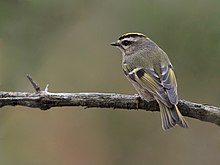Golden-crowned kinglet
| Golden-crowned kinglet | |
|---|---|
 |
|
| In Canada | |
| Scientific classification | |
| Kingdom: | Animalia |
| Phylum: | Chordata |
| Class: | Aves |
| Order: | Passeriformes |
| Family: | Regulidae |
| Genus: | Regulus |
| Species: | R. satrapa |
| Binomial name | |
|
Regulus satrapa (Lichtenstein, 1823) |
|
The golden-crowned kinglet (Regulus satrapa) is a very small songbird.
Adults are olive-gray on the upperparts with white underparts, with thin bills and short tails. They have white wing bars, a black stripe through the eyes and a yellow crown surrounded by black. The adult male has an orange patch in the middle of the yellow crown.
Their breeding habitat is coniferous forests across Canada, the northeastern and western United States, Mexico and Central America. They nest in a well-concealed hanging cup suspended from a conifer branch.
These birds migrate to the United States. Some birds are permanent residents in coastal regions and in the southern parts of their range. Northern birds remain further north in winter than the ruby-crowned kinglet.
They forage actively in trees or shrubs, mainly eating insects, insect eggs and spiders.
They give a series of high-pitched calls on a single note, and tend not to fear human approach.
Adults are olive-gray on the upperparts with white underparts, with thin bills and short tails. They have white wing bars, a black stripe through the eyes and a yellow crown surrounded by black. The adult male has an orange patch in the middle of the yellow crown. The juvenile is similar to the adult, but with a browner back and without the yellow crown. This is one of the smallest passerines in North America. Its length, at 8 to 11 cm (3.1 to 4.3 in), is probably the shortest of any American passerine. However, its weight, which averages around 5.9 g (0.21 oz), with a range of 4 to 7.8 g (0.14 to 0.28 oz), is marginally more on average than the American bushtit and black-tailed gnatcatcher.
Golden-crowned kinglet is a widespread North American bird, breeding in many US states, and over much of Canada, and wintering across much of the continent south to Florida, Texas and Mexico. It also occurs in isolated mountain ranges in southern Mexico and Guatemala, where it is represented by separate subspecies.
The kinglets are a small group of birds sometimes included in the Old World warblers, but frequently given family status, especially as recent research showed that, despite superficial similarities, the crests are taxonomically remote from the warblers. The names of the family, Regulidae, and its only genus, Regulus, are derived from the Latin regulus, a diminutive of rex, "a king", and refer to the characteristic orange or yellow crests of adult kinglets.
...
Wikipedia

